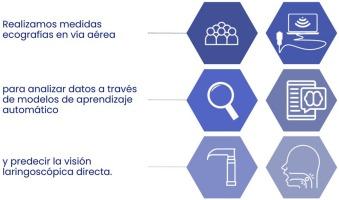基于超声波和体格检查的气道评估机器学习模型
IF 0.9
Q3 ANESTHESIOLOGY
Revista Espanola de Anestesiologia y Reanimacion
Pub Date : 2024-10-01
DOI:10.1016/j.redar.2023.12.002
引用次数: 0
摘要
目的 展示机器学习模型在利用临床和超声参数预测困难气道方面的实用性。 方法 这是一个前瞻性非连续性队列,对象是接受择期手术的患者。我们收集了年龄、性别、体重指数、OSA、Mallampatti、甲状腺距离、咬合试验、宫颈周径、宫颈超声测量值和喉镜检查后的 Cormack-Lehanne 分级作为预测变量。我们对预测变量与 Cormack-Lehanne 分级的关系进行了单变量分析,并对每个预测变量分别和组合应用随机森林技术设计了机器学习模型。我们发现了每种设计的 AUC-ROC、灵敏度、特异性以及阳性和阴性预测值。Cormack-Lehanne≥Ⅲ级患者的年龄、体重指数、宫颈周径、Mallampati分级≥Ⅲ级和咬合试验≥Ⅱ级均较高,其超声测量值也明显较高。基于体格检查的机器学习模型获得的 AUC-ROC 值优于超声测量值,但未达到统计学意义。我们称之为 "经典模型 "的物理变量组合在所有模型中获得了最高的 AUC-ROC 值 [0.75 (0.67-0.83)],与其他超声模型相比,这一差异具有统计学意义:NCT04816435。本文章由计算机程序翻译,如有差异,请以英文原文为准。

Modelos de aprendizaje automático basados en ecografía y exploración física para la evaluación de la vía aérea
Purpose
To demonstrate the utility of machine learning models for predicting difficult airways using clinical and ultrasound parameters.
Methods
This is a prospective non-consecutive cohort of patients undergoing elective surgery. We collected as predictor variables age, sex, BMI, OSA, Mallampatti, thyromental distance, bite test, cervical circumference, cervical ultrasound measurements, and Cormack-Lehanne class after laryngoscopy. We univariate analyzed the relationship of the predictor variables with the Cormack-Lehanne class to design machine learning models by applying the random forest technique with each predictor variable separately and in combination. We found each design's AUC-ROC, sensitivity, specificity, and positive and negative predictive values.
Results
We recruited 400 patients. Cormack-Lehanne patients ≥ III had higher age, BMI, cervical circumference, Mallampati class membership ≥ III, and bite test ≥ II and their ultrasound measurements were significantly higher. Machine learning models based on physical examination obtained better AUC-ROC values than ultrasound measurements but without reaching statistical significance. The combination of physical variables that we call the «Classic Model» achieved the highest AUC-ROC value among all the models [0.75 (0.67-0.83)], this difference being statistically significant compared to the rest of the ultrasound models.
Conclusions
The use of machine learning models for diagnosing difficult airways is a real possibility, although it is still in a very preliminary stage of development.
Clinical Registry
ClinicalTrials.gov: NCT04816435.
求助全文
通过发布文献求助,成功后即可免费获取论文全文。
去求助
来源期刊

Revista Espanola de Anestesiologia y Reanimacion
ANESTHESIOLOGY-
CiteScore
1.80
自引率
15.40%
发文量
113
审稿时长
82 days
 求助内容:
求助内容: 应助结果提醒方式:
应助结果提醒方式:


